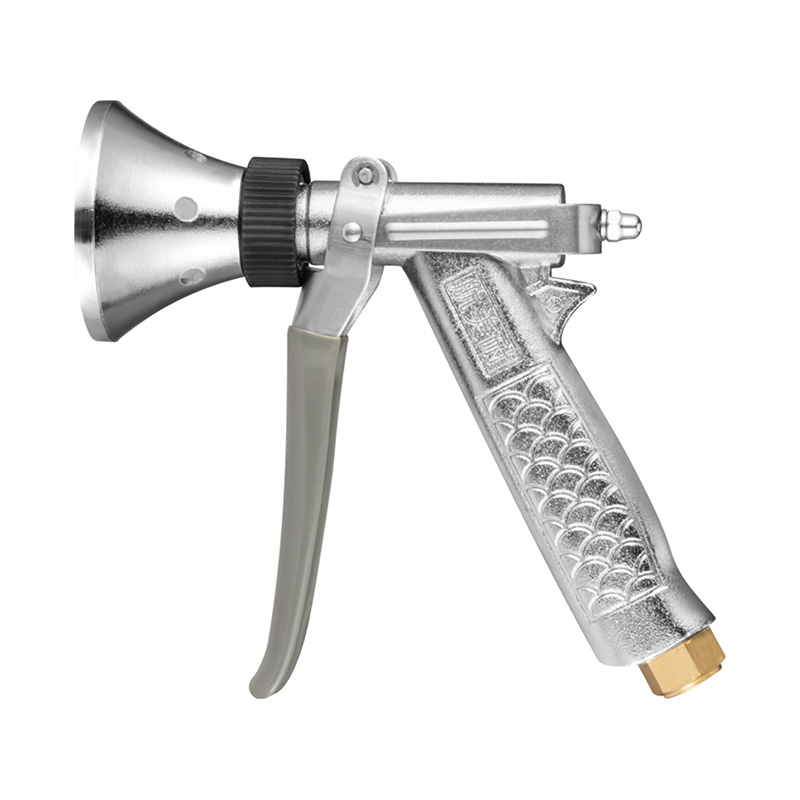This is an agricultural high-pressure short windpr...
See DetailsIn the agricultural sector, precision spraying has become a critical operation that affects crop quality, resource efficiency and long-term sustainability. Straight-barrel agricultural spray guns and agricultural high-pressure nozzles play an important role in the precise and controlled application of fertilizers, pesticides and water on a variety of terrains. Understanding how these components work and how to maintain them can help you achieve good results on every spraying task and avoid excessive input waste.

Learn about Straight-Barrel Agricultural Spray Guns
Straight-barrel agricultural spray guns are designed to provide a directed, steady stream of fluid for targeted applications. Their linear gun body structure helps operators maintain control and focus the spray where it is particularly needed, which is especially important when treating specific rows, foliage areas or confined greenhouse spaces.
Spray guns are typically made of corrosion-resistant metals and engineered polymers to withstand chemical attack, frequent operation and high operating pressures. Internal seals and gaskets prevent leaks that can reduce spraying accuracy. Some models are equipped with an adjustable trigger or pressure controller, allowing operators to fine-tune the output rate for each treatment cycle.
When used with a high-pressure nozzle, the gun's versatility is even greater, with the ability to switch from a fine spray to a denser, more powerful spray. This flexibility helps adjust spraying operations to changing weather conditions, crop maturity and field structure.
Selecting Agricultural High Pressure Spray Nozzles
Choosing the correct nozzle is essential for achieving the desired coverage and droplet characteristics. High pressure nozzles are engineered to handle significant flow rates while maintaining consistent droplet size and distribution. Different orifice designs and materials create options suitable for a variety of tasks.
Fan nozzles, for example, produce a wide, even spray pattern that can efficiently cover larger leaf surfaces. Conical or hollow cone nozzles create more focused sprays ideal for penetrating dense canopies or targeting pests hidden within foliage layers. Straight stream nozzles deliver narrow, concentrated jets that help when precise spot treatment is necessary.
Material choice also influences performance and longevity. Brass, stainless steel, and engineered polymers each offer varying degrees of resistance to abrasion and chemical degradation. Operators working with aggressive chemical solutions often prefer nozzles with enhanced corrosion resistance to maintain spray quality over time.
Installation and Calibration Practices
To achieve consistent performance, proper installation and calibration are critical. Before attaching nozzles to the spray gun, fittings should be cleaned to remove debris or residue that could affect flow. Thread sealing tape or appropriate gaskets help secure leak-free connections, particularly at high operating pressures.
Calibrating the system ensures that the flow rate matches the intended application rate for each treatment. This process involves measuring the output over a fixed period and comparing it to recommended guidelines. A well-calibrated setup reduces under- or over-application, helping manage costs and environmental impact.
Operators should also verify that pressure gauges and regulators are functioning correctly before each use. Inaccurate pressure readings can result in inconsistent droplet size or unintended drift during spraying.
Operational Considerations for Uniform Coverage
Spray consistency depends not only on the hardware but also on operational technique. Maintaining steady hand movement, consistent walking speed, and stable trigger pressure are necessary to create uniform coverage across the target area.
Environmental factors such as temperature, wind speed, and humidity also affect how droplets behave once released. Spraying early in the morning or late in the day when conditions are calmer often produces more predictable results. In windy environments, adjusting the nozzle angle and selecting a larger droplet size can help reduce drift and improve contact with plant surfaces.
Operators should periodically monitor the spray pattern by conducting test passes on a flat surface or use pattern-check tools to confirm that nozzles are producing the expected coverage.
Maintenance Strategies for Long-Term Performance
Routine maintenance helps preserve the effectiveness of both straight agricultural spray guns and high pressure nozzles. After each use, the system should be flushed with clean water to remove any remaining chemical residues that could dry and clog internal passages.
Disassembling nozzles for inspection is a practical step to identify wear or blockages early. Specialized brushes or cleaning tools are recommended to clear deposits without enlarging or damaging the orifice. Regularly checking O-rings and seals prevents leaks that can develop from normal wear.
Proper storage also extends equipment life. Spray guns and nozzles should be kept in a clean, dry environment protected from direct sunlight and high temperatures. Before long periods of inactivity, lubricating moving parts and storing components in protective cases helps ensure readiness for the next season.
Supporting Precise Agricultural Applications
Straight agricultural spray guns combined with agricultural high pressure spray nozzles represent an adaptable solution for farms with diverse application requirements. Their versatility allows producers to adjust spraying strategies in response to specific crop stages, pest pressures, and environmental conditions.
Operators who invest time in selecting compatible components, calibrating equipment, and adopting sound maintenance practices are better positioned to achieve steady application results. This careful approach can also contribute to improved resource efficiency and help meet evolving regulatory expectations around chemical use.